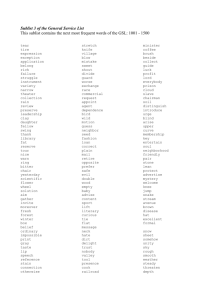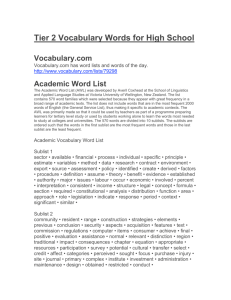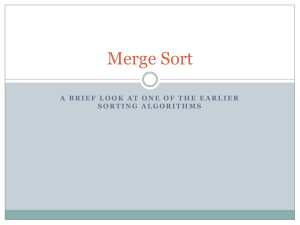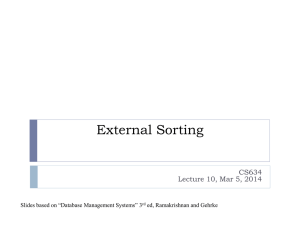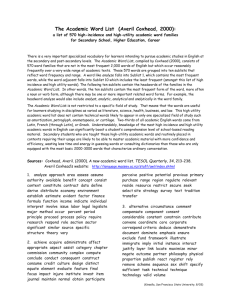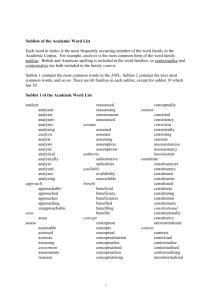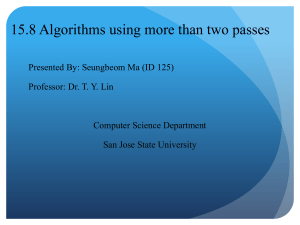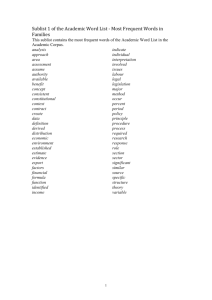CS257_15.4_ppt
advertisement
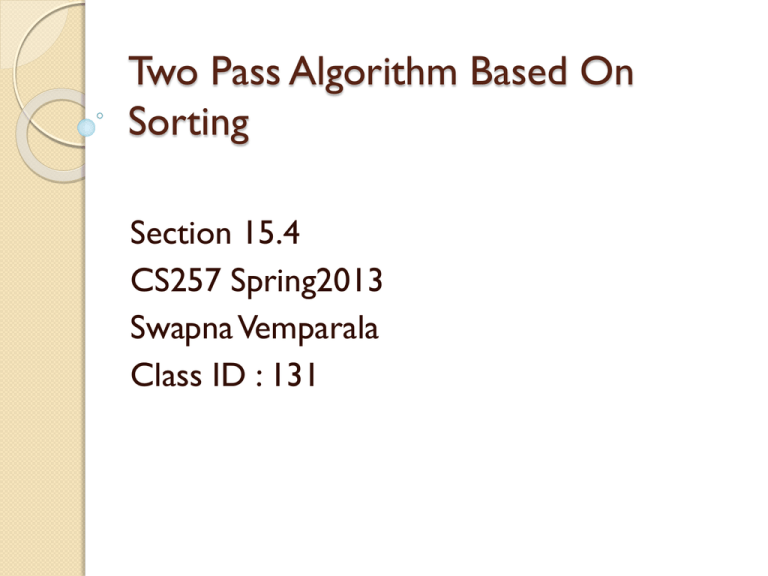
Two Pass Algorithm Based On Sorting Section 15.4 CS257 Spring2013 Swapna Vemparala Class ID : 131 Contents Two-Pass Algorithms Two-Phase, Multiway Merge-Sort Duplicate Elimination Using Sorting Grouping and Aggregation Using Sorting A Sort-Based Union Algorithm Sort-Based Intersection and Difference A Simple Sort-Based Join Algorithm A More Efficient Sort-Based Join Two-Pass Algorithms Data from operand relation is read into main memory, processed, written out to disk again, and reread from disk to complete the operation. 15.4.1 Two-Phase, Multiway MergeSort To sort very large relations in two passes. Phase 1: Repeatedly fill the M buffers with new tuples from R and sort them, using any main-memory sorting algorithm. Write out each sorted sublist to secondary storage. Phase 2 : Merge the sorted sublists. For this phase to work, there can be at most M — 1 sorted sublists, which limits the size of R. We allocate one input block to each sorted sublist and one block to the output. Merging Find the smallest key Move smallest element to first available position of output block. If output block full -write to disk and reinitialize the same buffer in main memory to hold the next output block. If this block -exhausted of records, read next block from the same sorted sublist into the same buffer that was used for the block just exhausted. If no blocks remain- stop. 15.4.2 Duplicate Elimination Using Sorting Same as previous… Instead of sorting on the second pass, repeatedly select first unconsidered tuple t among all sorted sub lists. Write one copy of t to the output and eliminate from the input blocks all occurrences of t. Output - exactly one copy of any tuple in R. 15.4.3 Grouping and Aggregation Using Sorting Read the tuples of R into memory, M blocks at a time. Sort the tuples in each set of M blocks, using the grouping attributes of L as the sort key. Write each sorted sublist to disk. Use one main-memory buffer for each sublist, and initially load the first block of each sublist into its buffer. Repeatedly find the least value of the sort key present among the first available tuples in the buffers. 15.4.4 A Sort-Based Union Algorithm In the first phase, create sorted sublists from both R and S. Use one main-memory buffer for each sublist of R and S. Initialize each with the first block from the corresponding sublist. Repeatedly find the first remaining tuple t among all the buffers 15.4.5 Sort-Based Intersection and Difference For both set version and bag version, the algorithm is same as that of set-union except that the way we handle the copies of a tuple t at the fronts of the sorted sub lists. For set intersection -output t if it appears in both R and S. For bag intersection -output t the minimum of the number of times it appears in R and in S. For set difference -output t if and only if it appears in R but not in S. For bag difference-output t the number of times it appears in R minus the number of times it appears in S. 15.4.6 A Simple Sort-Based Join Algorithm Given relations R(X,Y) and S(Y, Z) to join, and given M blocks of main memory for buffers Sort R, using 2PMMS, with Y as the sort key Sort S similarly Merge the sorted R and S, use only two buffers 15.4.8 A More Efficient Sort-Based Join If we do not have to worry about very large numbers of tuples with a common value for the join attribute(s), then we can save two disk 1/0's per block by combining the second phase of the sorts with the join itself To compute R(X, Y) ►◄ S(Y, Z) using M main-memory buffers Create sorted sublists of size M, using Y as the sort key, for both R and S. Bring the first block of each sublist into a buffer Repeatedly find the least Y-value y among the first available tuples of all the sublists. Identify all the tuples of both relations that have Y-value y. Output the join of all tuples from R with all tuples from S that share this common Y-value Thank you
